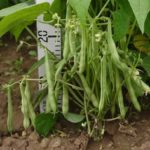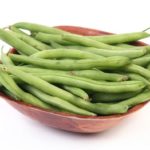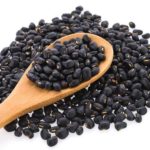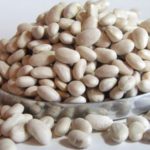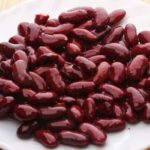The history of beans is almost 7 thousand years. It belongs to the legume family, currently more than 250 species are known, but about 20 of them are most often used, including climbing ones. Culture has a rich history owing to no less rich, very useful composition: a complete set of vitamins, a huge range of micro and macro elements, fiber, carbohydrates, fats, pectin and vegetable protein, so important for a person, whose content is only inferior to meat! What kind of beans we learn from the article.
Table of contents
Types of beans
There are many different types and varieties of this crop, but for anyone there are general rules for growing and caring. Any type of bean is thermophilic, therefore it is necessary to plant seeds in the first half of May when the soil warms up to 12-14 degrees. For a quicker shoot, it is recommended to soak the seeds overnight in water, and just before sowing - for 5 minutes in a solution of boric acid. This will strengthen the seedlings, increase crop yields.

Growing bush beans
This species looks like small bushes up to 60 cm high. It can grow in the shade of tall trees, between currant bushes, gooseberries, but it is impossible to shade too much - it will affect the yield. Planting depth - not more than 2 cm, otherwise the seeds will die even during swelling in the soil. The plant loves fertilized with humus soil, responds well to fertilizing with nutrients. It is possible to plant rather densely - rows at a distance of 30 cm, between seeds - 4-5 cm.
Spray beans require double hilling for greater stability.From the moment of emergence and until ripening of tender green beans, it takes about 55 days. Pods, edible, very delicate in taste, fiberless, especially in sugar varieties.
Green or green
It was the Italians who first guessed to use unripe pods from Europeans. Dishes from green or yellow pods of French beans have a surprisingly delicate taste, very low calorie content - only 25kkal / 100g of product, rich in vitamins and trace elements (more than in grains), although the protein content is inferior to dry grains. Green beans gives excellent yields. Its use for the body is also difficult to overestimate:
- helps to improve digestion;
- lowers blood sugar levels;
- high levels of sulfur has a preventive effect in infectious diseases of the intestine;
- Fiber, protein, carbohydrates, trace elements have a beneficial effect on the state of the body, in particular, improve the structure of hair and skin.
- Spray Beans
- Curly beans
- Green Beans
Curly variety
The following characteristics are common to them:
- unpretentiousness and high growth rate, giving the opportunity to bloom and bear fruit from mid-June until the onset of cold weather;
- variety of shapes and colors of inflorescences, pods, grains;
- soil enrichment with nitrogen.
Regular gathering of pods throughout the summer stimulates the formation of new ovaries. With a small occupied space, the curly view of this culture gives an excellent harvest, if you tie it in time, it performs a decorative function, so it can be planted at the fence, arbor, under the balcony. Growing conditions and beneficial properties are the same as in other types of culture.
Asparagus or vegetable
This is a relatively recently bred variety of beans for use exclusively in the green (immature) form. The pods are green or yellow (depending on the variety), thin, 12-15 cm long, very delicate taste, juicy, sugar flesh, without coarse fibers. The bushes are low - from 30 to 70 cm, compact, but, despite the size of the plant, they give up to 1 kg of beans per season.
All varieties of beans can be divided into sugar and semi-sugar. Sugar plants are intended for eating pods that have a circular cross-section filled with a gel-like substance. The semi-sugar pods are flatter, the jelly is much smaller than the first ones.Such varieties are universal: both pods and grain are suitable for use.
In order to have a good harvest all summer long, it is necessary to plant different varieties taking into account their maturity dates - from early ripening varieties (65 days from sprouting to technical ripening) to late (100 days). Small bushes do not need props, are resistant to cold, early ripening.

Purple
In addition to the usual green and yellow string beans, plants with dark purple pods have taken root well in the gardens: the variety Bluekhilda (Germany), the Violet King (Austria), etc. First, the ovary on the vines of the usual green color, but when the pods reach a length of 10 cm, the color immediately changes to purple.
If we compare these two varieties, the pods of Bluekhilda are more fleshy, but before the ripening of the sash coarsen, fibers appear. Grains of beige color, oily, very tender and tasty, quickly crush. The beans of the Purple King are flat, less fleshy, but without the parchment layer, they are as good as the first. In the process of cooking change color to green.
Shelling (grain)
For example, in central Russia, the grains of such varieties do not ripen, and the pods, even in the early stages of ripening, have a dense fibrous structure that is not fit for human consumption.
But, of course, if you grow them in a warm climate zone, you can get an excellent harvest of very nutritious, rich in vitamins and minerals, with high protein content of grains.
The most common varieties: Ballad, Ruby, Golden, Barbara, Generous, etc. They are valued for their high yield and taste.
- Purple beans
- Haricot bean
What color is the bean?
White
Grains of such beans have a milky-white color, a solid structure. The main advantage of white beans - high protein content - 20%. In terms of benefits to the body, it is comparable only with beef protein, and, moreover, it is devoid of animal fat, which makes it difficult for people to assimilate such vital matter.
Beneficial features:
- removes slags and toxins;
- reduces the level of bad cholesterol in the blood;
- has a beneficial effect on the cardiovascular system;
- can be used during diets, as it is saturated with nutrients at low calorie (120kkal / 100g).
Red
Red grains are low-calorie (94kcal), contain a large amount of vitamins B6, B12, B1, A, C, E, PP, amino acids, lysine, arginine, magnesium, calcium, iron, copper, zinc, etc. Due to such a rich chemical composition, red beans have a beneficial effect on the functioning of many organs and systems of the human body. - nervous, circulatory, digestive tract, strengthens the immune system, improves the condition of hair, teeth, skin.
Black
Grain Benefits black color enhanced by an even greater concentration of all the ingredients included in their composition.
- Black
- White beans
- Red
Black grains are most often found in Latin American dishes, have a sweet taste and smoked flavor. Black beans are the most rich in chemical composition, nutritional and medicinal values, they occupy the first place among the products of plant origin. Suffice it to say that black beans are the most useful food for the prevention of cancer and diabetes.
As you can see, the benefits of this product can not be overestimated. Drinking beans at least twice a week in different forms - salads, first, second courses, etc.- will certainly have a beneficial effect on your body. Even outwardly it will become noticeable - velvet skin, shiny hair, beautiful nails are provided to you with regular use of beans in general and black - in particular.

